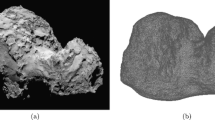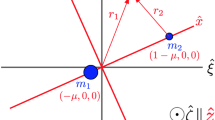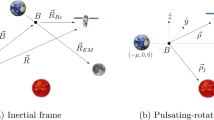Abstract
Planet Earth is a constant target to various astronomical objects. Larger ones manage to overcome the natural barrier imposed by the atmosphere, colliding with the ground and causing damage to Earth’s surface. With these events in mind, this work proposed the implementation of several modules for a previously existing N-body simulator in Python® to study the entry of multiple objects into the Earth’s atmosphere and analyze the effects of possible impact scenarios. Among the modules implemented are a coordinate converter to the Earth-Centered Earth-Fixed (ECEF) reference frame, an atmospheric density model along with its corresponding drag force, a fragmentation/disintegration evaluation from the objects interaction with Earth’s atmosphere (based on a stochastic model specifically applied for the purposes of this study), an impact radius calculator and, finally, ECEF trajectory and impact zone visualization. From the possibility of fragmentations (addition of bodies) or disintegrations (removal of bodies), the algorithm developed also made it possible to run numerical integrations with a variable number of objects, dynamically updating the number of bodies and equations of motion mid simulation. At last, a few case studies were executed to generate results that made it possible to evaluate the successful implementation of all the modules.

















Similar content being viewed by others
Data Availability
Data sharing is not applicable to this article as no datasets were generated or analyzed during the current study.
References
Bate, R.R., Mueller, D.D., White, J.E.: Fundamentals of Astrodynamics. Dover Publications, New York (1971)
Braeunig, R.A.: Atmospheric models. http://www.braeunig.us/space/atmmodel.htm. Accessed 01 June 2021 (2014)
Carter, R.T., Jandir, P.S., Kress, M.E.: Estimating the drag coefficients of meteorites for all mach numbers regimes. In: 40th Lunar and Planetary Science Conference (2009)
Dadalto, M.D.: Simulador para problema de n-corpos considerando uma vela solar plana. Technical report, Departamento de Engenharia Mecânica, Universidade Federal de Minas Gerais (2019). Trabalho de Conclusão do Curso de Engenharia Aerospacial na Universidade Federal de Minas Gerais
Ghiorzi: Dias Julianos. http://ghiorzi.org/diasjuli.htm. Accessed 04 June 2021 (2020)
Hedin, A.E.: Extension of the msis thermosphere model into the middle and lower atmosphere. J. Geophys. Res. Space Phys. 96(A2), 1159–1172 (1991)
Jacchia, L.G.: Static diffusion models of the upper atmosphere with empirical temperature profiles. Smithsonian Contrib. Astrophys. 8, 215 (1965)
Jacchia, L.G.: Revised static models of the thermosphere and exosphere with empirical temperature profiles. SAO Spec. Rep. 332, 986 (1971)
Kuga, H.K., Rao, K.R., Carrara, V.: Introdução à Mecânica Orbital, 2nd edn. Instituto Nacional de Pesquisas Espaciais, BH (2008)
Martin, R.C.: Clean Architecture: A Craftsman’s Guide to Software Structure and Design. Prentice Hall, Boston (2017)
McBurney, P.: Asteroid Damage Visualization Map. https://asteroidcollision.herokuapp.com/. Accessed 09 July 2021 (2020)
Meireles, L.G.: Sistemas de Coordenadas e Suas Transformações em Dinâmica Orbital, São José dos Campos (2020)
National Oceanic and Atmospheric Administration, National Aeronautics and Space Administration, United States Air Force: US Standard Atmosphere 1976, Washington, D.C. (1976)
Nwankwo, V.U.J., Chakrabarti, S.K.: Theoretical model of drag force impact on a model international space station satellite due to solar activity. Trans. Jap. SoC. Aeronau. Space Sci. Aerosp. Technol. Japan 12, 47–53 (2014)
Oceanic, N., Atmospheric Administration, N.A., Space Administration, U.S.A.F.: U.S. Standard Atmosphere, 1962, Washington, D.C. (1962)
The Planetary Society: Defend Earth. https://www.planetary.org/defend-earth. Accessed 30 May 2021 (2021)
Vallado, D.A., McClain, W.D.: Fundamentals of Astrodynamics and Applications. Space Technology Library, New York (2013)
Acknowledgements
The authors would wish to express their appreciation for the support provided by grant # 2018/19959-0 from São Paulo Research Foundation (FAPESP) and for the financial support from the National Council for the Improvement of Higher Education (CAPES).
Author information
Authors and Affiliations
Corresponding author
Additional information
Publisher's Note
Springer Nature remains neutral with regard to jurisdictional claims in published maps and institutional affiliations.
Rights and permissions
Springer Nature or its licensor (e.g. a society or other partner) holds exclusive rights to this article under a publishing agreement with the author(s) or other rightsholder(s); author self-archiving of the accepted manuscript version of this article is solely governed by the terms of such publishing agreement and applicable law.
About this article
Cite this article
Quattrucci, R.D., Meireles, L.G. & Pereira, M.C. Implementation and study of a drag model for an N-body problem simulator. Celest Mech Dyn Astron 135, 5 (2023). https://doi.org/10.1007/s10569-022-10119-y
Received:
Revised:
Accepted:
Published:
DOI: https://doi.org/10.1007/s10569-022-10119-y




